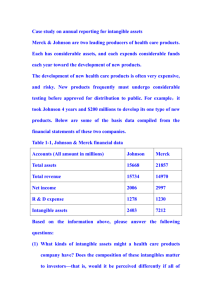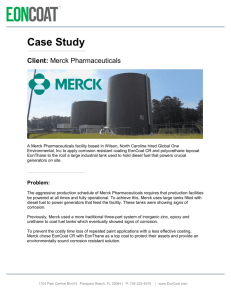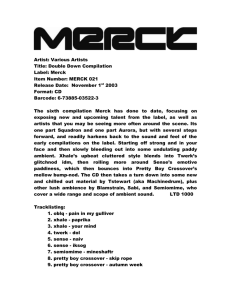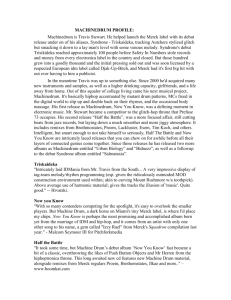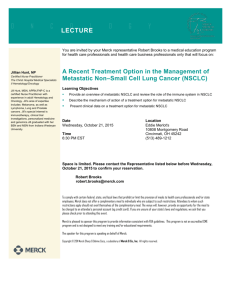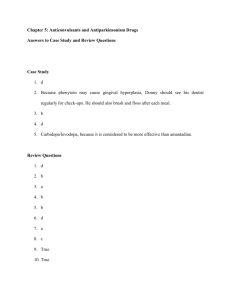Neuro, References
advertisement
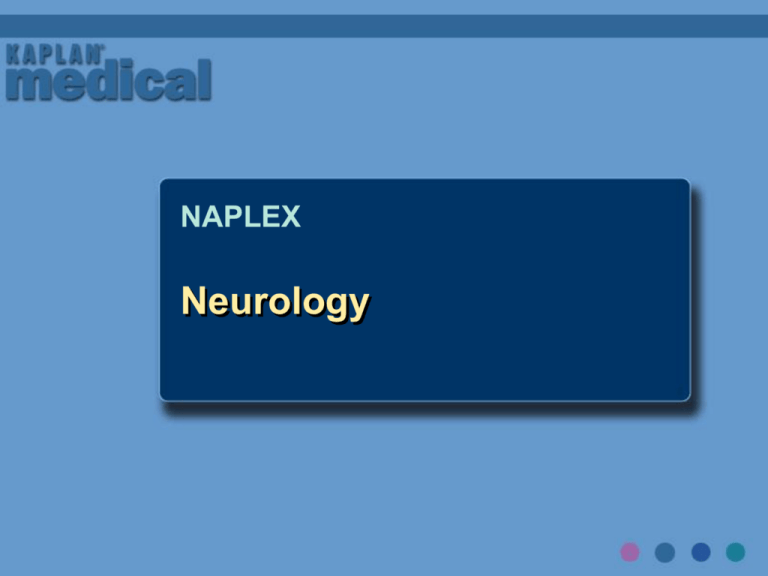
NAPLEX Neurology NAPLEX Drugs used for Convulsive Disorders PG 88 The medication lorazepam (Ativan) has which of the following pharmacological activities? a. sedative/hypnotic b. anticonvulsant c. muscle relaxant d. anxiolytic e. all of the above The medication lorazepam (Ativan) has which of the following pharmacological activities? a. sedative/hypnotic b. anticonvulsant c. muscle relaxant d. anxiolytic e. all of the above Major Types of Convulsive Disorders • Partial – generally involves only one hemisphere of the brain (initially) and asymmetrical: Simple-no loss of consciousness Complex-loss of consciousness Phenytoin, carbamazepine, barbiturates, valproate • Generalized – generally involves both hemispheres of the brain; bilateral/symmetrical: absence, myoclonic, clonic, tonic, tonic-clonic, Valproate, lamotrigine, carbamazepine, ethosuximide • Status epilepticus—30 minutes of continuous seizures or five minutes of convulsive seizures. Lorazepam is drug of choice; midazolam or propofol PG 88 Anticonvulsant Drugs AED monotherapy is preferred, but some patients do require combination therapy. PG 89-90 First-line AEDs for partial seizures include carbamazepine, phenytoin, lamotrigine, valproic acid, and oxcarbazepine. First-line AEDs for generalized absence seizures include valproic acid and ethosuximide. First-line AEDs for tonic-clonic seizures include phenytoin, carbamazepine, and valproic acid. Alternative AEDs include gabapentin, topiramate, levetiracetam, zonisamide, tiagabine, primidone, felbamate, lamotrigine, and phenobarbital. PG 89-90 PG 89-90 Which of the following medications is NOT an inducer of the liver CYP450 system? a. carbamazepine b. phenytoin c. valproate d. olanzapine e. phenobarbital Which of the following medications is NOT an inducer of the liver CYP450 system? a. carbamazepine b. phenytoin c. valproate d. olanzapine e. phenobarbital Valproic acid is available in which of the following dosage forms? I. Capsules II. Liquid III. Tablets a. I only b. III only c. I and II only d. II and III only e. I, II, and III Valproic acid is available in which of the following dosage forms? I. Capsules II. Liquid III. Tablets a. I only b. III only c. I and II only d. II and III only e. I, II, and III A drug specific for petit mal is: a. clonazepam b. diazepam c. flurazepam d. lorazepam e. oxazepam A drug specific for petit mal is: a. clonazepam b. diazepam c. flurazepam d. lorazepam e. oxazepam Which of the following has no known drug interaction with oral contraceptives? a. Neurontin b. Carbamazepine c. Valproic Acid d. Phenytoin e. Topiramate Which of the following has no known drug interaction with oral contraceptives? a. Neurontin b. Carbamazepine c. Valproic Acid d. Phenytoin e. Topiramate NAPLEX Drugs to Treat Parkinson’s Disease Drugs to Treat Parkinson Disease Causes of Parkinson disease Disruption of dopaminergic / cholinergic balance Characteristics of patients (TRAP) Slow onset; Tremor, Rigidity, Akinesia, Postural instability Drug therapy Goals – Mainly palliative; attempt to inhibit cholinergic and attenuate dopaminergic action PG 91 Drugs to Treat Parkinson Disease (cont’d) Anticholinergic Drugs. Watch for dry mouth, constipation, urinary retention, intraoccular pressure • Procyclidine (Kemadrin) • Trihexyphenidyl (Artane) • Benztropine (Cogentin) • Biperiden (Akineton) • Diphenhydramine (Benadryl) PG 91 Bradykinesia is best defined as: a. slow movements b. rapid heart rate c. narrowing of the pupil d. excessive sweating e. loss of desire for pleasurable activities Bradykinesia is best defined as: a. slow movements b. rapid heart rate (tachycardia) c. narrowing of the pupil (miosis) d. excessive sweating (diaphoresis) e. loss of desire for pleasurable activities (apathy) Drugs to Treat Parkinson Disease (cont’d) Dopaminergic Agents • Levodopa (Larodopa, Dopar) - watch for on-off effect and B6 decreases efficacy, iron increases absorption • Levodopa/carbidopa (Sinemet) - wait 8 hours if converting from levodopa. Cut levodopa dose to 25% of original. • Amantadine (Symmetrel) - increases release of dopamine stores (hypersensitivity); antiviral properties - antiviral for flu • Ergot-derived dopamine receptor agonists - stimulate dopamine receptors; (a) bromocriptine mesylate (Parlodel), and (b) pergolide mesylate (Permax) PG 91 Drugs to Treat Parkinson Disease (cont’d) • Nonergot dopamine receptor agonists - stimulate dopamine receptors; (a) pramipexole (Mirapex), (b) ropinirole (Requip), and (c) rotigotine (Neupro Transdermal) --- ropinirole approved to Restless Leg Syndrome • COMT inhibitors - adjunct that extends the action of levodopa/carbidopa; (a) Tolcapone (Tasmar), monitor hepatic function, and (b) entacapone (Comtan) ---no monotherapy • MAO-B inhibitor-adjunct that decreases breakdown of dopamine; (a) selegiline (Eldepryl, Emsam, Zelapar), (b) rasagiline (Azilect) ---watch for MAO-inhibitor drug interactions PG 92 What information should the doctor know prior to initiating Mirapex in a patient with Parkinson’s Disease? I. Decrease the levodopa dose by 20-30% when initiating Mirapex II. Patient must wear patch for 24 hours for efficacy III. Monitor for serious cardiac side effects a. I only b. III only c. I and II only d. II and III only e. I, II, III What information should the doctor know prior to initiating Mirapex in a patient with Parkinson’s Disease? I. Decrease the levodopa dose by 20-30% when initiating Mirapex II. Patient must wear patch for 24 hours for efficacy III. Monitor for serious cardiac side effects a. I only b. III only c. I and II only d. II and III only e. I, II, III NAPLEX Alzheimer's Drugs p. 118 Drugs for Alzheimer’s Disease Cholinesterase inhibitors: all enhance cholinergic activity • Donepezil (Aricept) • Galantamine (Razadyne) (Reminyl – D/C)) • Rivastigmine (Exelon) Glutamate antagonists • Memantine (Namenda) Miscellaneous agents • Vitamin E • Selegiline (Eldepryl) p. 118 Cholinesterase Inhibitors Dosing • Dose dependent side effects require titration • Start low and take in steps to avoid side effects Drug Starting dose Time before Increasing dose 6 weeks Increase dose by Max dose Donepezil (Aricept) 5mg QHS 5mg QHS 10mg QHS Rivastigmine 1.5mg BID (Exelon) 2 weeks 1.5mg BID 6mg BID Galantamine 4mg BID (Razadyne) 4 weeks 4mg BID Recommended range of 16-24 mg a day. p. 118 Drugs for Alzheimer’s Disease Adverse Effects Cholinesterase inhibitors: • Hepatotoxicity • Cholinergic effects (N/D, anorexia, salivation) • Bradycardia • Headache Glutamate antagonists • Hypertension • Tachycardia • Insomnia p. 118 NAPLEX Reference Sources for Pharmacists PG 399 Literature Review PG 399 Primary literature Original journal articles (research reports, case reports, editorials); serves as information for development of secondary and tertiary literature resources Secondary literature Indexing and abstracting services (e.g. MEDLINE, IPA, EMBASE, Cochrane) Tertiary literature Textbooks and review articles; summarize and interpret primary literature References USP-NF Official monographs for drug structure, solubilities, assays and therapeutic category Limited info on dosage, dosage forms USP DI (Micromedex) Three volume set • I---DI for healthcare professionals (“package insert”) 11,000 drug products • II---Advice for patients – easy to understand • III---Approved Drug products, legal requirements, Orange book PG 399 FDA Orange Book (electronic - 2004) Bioequivalence information References Remington’s “Pharmacy encyclopedia” – pharmacology, theoretical science, sterilization, practical pharmacy practice Facts and Comparisons AHFS PG 399 Rx and OTC by therapeutic category – monthly updates Good info on drug pharmacology – intended for institutional Blue Book / Red Book Drugs / OTC / Cosmetics Prices, NDC numbers, manufacturer address References PG 399 Physician’s Desk Reference (PDR) White pages—manufacturer index of products Pink pages—product names by trade name Blue pages—products by therapeutic category Yellow pages—generic and trade names with colored product ID Martindale’s Comprehensive drug lists (think foreign products - EUP) Merck Manual Describes diseases by symptoms Merck Index Listing of chemicals Drugs in Pregnancy and Lactation (Briggs) Gold standard A comparison of the relative daily cost of six brands of HCTZ can most easily be obtained by using the: a. Martindale’s Extra Pharmacopeia b. Facts and Comparisons c. Red Book/Blue Book d. Merck Index e. Remington’s A comparison of the relative daily cost of six brands of HCTZ can most easily be obtained by using the: a. Martindale’s Extra Pharmacopeia (drug lists foreign) b. Facts and Comparisons (therapuetics) c. Red Book/Blue Book (prices & NDCs) d. Merck Index (list of chemicals) e. Remington’s (pharmacology) Which of the following items is NOT presented in USP DI Volume III: a. Description of therapeutic uses for drugs b. List of orphan drugs c. Description of good pharmacy compounding practices d. Definition of official storage conditions e. The Federal Controlled Substances Act Which of the following items is NOT presented in USP DI Volume III: a. Description of therapeutic uses for drugs b. List of orphan drugs (Martidale) c. Description of good pharmacy compounding practices (“a handbook on compounding”) d. Definition of official storage conditions (Remington's or AHFS) e. The Federal Controlled Substances Act (Guide to Federal Pharmacy Law) Compilation of information concerning parenteral drug solutions are found in: a. Goodman and Gilman b. Martindale’s c. Merck Index d. Remington’s e. Trissel’s Compilation of information concerning parenteral drug solutions are found in: a. Goodman and Gilman b. Martindale’s c. Merck Index d. Remington’s e. Trissel’s Solubility data for potassium gluconate will be found in: I. Merck Index II. USP-NF III. Remington’s a. I only b. III only c. I and II only d. II and III only e. I, II, and III Solubility data for potassium gluconate will be found in: I. Merck Index II. USP-NF III. Remington’s a. I only b. III only c. I and II only d. II and III only e. I, II, and III Contraindications for a commercial prescription drug may be located in: I. PDR II. Merck Manual III. USP-NF a. I only b. III only c. I and II only d. II and III only e. I, II, and III Contraindications for a commercial prescription drug may be located in: I. PDR II. Merck Manual III. USP-NF a. I only b. III only c. I and II only d. II and III only e. I, II, and III PG.40 What is the generic name for Actos? a. Indinavir b. Glyburide c. Pioglitazone d. Rosiglitazone e. Zafirlukast The pharmacist should inform the patient that the Actos: a. must be taken first thing in the morning before breakfast b. must be taken with the evening meal c. must be taken approximately 1 h before bedtime d. requires consumption of at least 1 glass of water e. may be taken any time during the day The pharmacist should inform the patient that the Actos: a. must be taken first thing in the morning before breakfast b. must be taken with the evening meal c. must be taken approximately 1 h before bedtime d. requires consumption of at least 1 glass of water e. may be taken any time during the day Which of the following cold remedies would be suitable for Ms Doolittle’s cough? I. Robitussin DM II. Robitussin AC III. Robitussin PE a. I only b. III only c. I and II only d. II and III only e. I, II, and III Which of the following cold remedies would be suitable for Ms Doolittle’s cough? I. Robitussin DM II. Robitussin AC III. Robitussin PE a. I only b. III only c. I and II only d. II and III only e. I, II, and III Which one of the following analgesics is most suitable to relieve the fever and headache of Ms. Doolittle’s 3-year-old boy? a. Anacin b. Ascriptin c. Bayer PM d. Panadol e. Bayer Children’s Aspirin Which one of the following analgesics is most suitable to relieve the fever and headache of Ms. Doolittle’s 3-yearold boy? a. Anacin b. Ascriptin c. Bayer PM d. Panadol (acetaminophen) e. Bayer Children’s Aspirin Reye Syndrome – 1970s – caused by inborn error of metabolism or toxin – peak onset age 6, Which one of the following drug products has the same active ingredient as Calan? a. Dyazide b. Effexor c. Isordil d. Plendil e. Verelan Which one of the following drug products has the same active ingredient as Calan? a. Dyazide b. Effexor c. Isordil d. Plendil e. Verelan Bactrim DS is probably being used to treat which of the following microorganisms? a. b. c. d. e. Chlamydia pneumoniae Clostridium difficile Enterococcus faecalis Escherichia coli Pseudomonas aeruginosa Bactrim DS is probably being used to treat which of the following microorganisms? a. b. c. d. e. Chlamydia pneumoniae Clostridium difficile Enterococcus faecalis Escherichia coli Pseudomonas aeruginosa Which of the following lab alterations would you expect to see in Ms. Brown as a result of starting the Bactrim DS? a. b. c. d. e. Increased INR Decreased INR Increased potassium Decreased potassium Increased sodium Which of the following lab alterations would you expect to see in Ms. Brown as a result of starting the Bactrim DS? a. b. c. d. e. Increased INR Decreased INR Increased potassium Decreased potassium Increased sodium A patient recently moved to the United States from England. She brings in her prescription bottle and asks the pharmacist if they carry the antibiotic that she has been taking for a UTI. Which of the following references could be used by the pharmacist to determine if there is an equivalent antibiotic available in the United States? Facts and Comparisons b. Martindale c. Merck Index d. PDR e. Red Book a. A patient recently moved to the United States from England. She brings in her prescription bottle and asks the pharmacist if they carry the antibiotic that she has been taking for a UTI. Which of the following references could be used by the pharmacist to determine if there is an equivalent antibiotic available in the United States? Facts and Comparisons b. Martindale c. Merck Index d. PDR e. Red Book a. THANKS!!!!!
